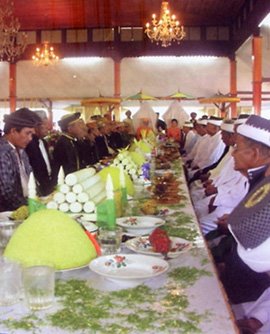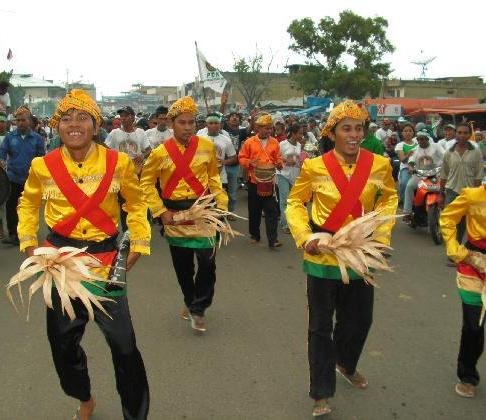(By : Busranto Abdullatif Do'a, S.Pd)
Traditionally, wedding ceremony of Ternate is closely braid between two clans (called; Soa) or between one family with another. By joining these two clans or family closely through married, every one in these two families has the same responsibilities to support the survival of these clans in the community, as well as the tradition of Ternate.
Traditionally, wedding ceremony of Ternate is closely braid between two clans (called; Soa) or between one family with another. By joining these two clans or family closely through married, every one in these two families has the same responsibilities to support the survival of these clans in the community, as well as the tradition of Ternate.
 So that, married is the starting point of extending family relation between clans (Soa) in Ternate community in order to support the extence of these clans and their position in the structure of traditional community of Ternate people.
So that, married is the starting point of extending family relation between clans (Soa) in Ternate community in order to support the extence of these clans and their position in the structure of traditional community of Ternate people.In traditional married ceremony, families from both sides (clans) have a special ceremony before coming to wedding reception that is called: Saro-saro. Saro-saro is kind of ritual ceremony where many kinds of delicacies meals are symbolically served, which have philosophy sides meaning.
These kinds of delicacies meals are served by woman (mothers and aunts) of both candidates of brides, which is called: Yaya se Goa. Yaya se Goa have a very important role in the execution and the survival of the bride because they responsibled for the continuation and the united of the bride as well as the families in the future.

Kinds of meals served by Yaya se Goa have symbolic meanings for the bride, and also as blessing of God. These kinds of delicacies meals philosophically can be interpreted as follows.
Saro-saro consists of:
1. Sirikaya: made of eggs, sugar, coconut milk, and the essence of pandanut leaf. The taste of sirikaya: nice, greasy and delicious. The bride is hopefully be happy and resolute in facing the misfortune.
2. Kobo: bufallo ketupat (rice cookied in a fist-size of young coconut leaves). The characters of a bufallo is powerful, dilligent and loyal. It is hopefully, the husband could have this character and responsible in running the family.
3. Nanasi: pineaple ketupat. Pineaple hide is merciless and thorny but attractive and delicious. The attributes of pineaple hopefully be the characters of the wife, that is loyal to the household, and resolute in facing the temptation.
The second ceremony after saro-saro is what the Ternatenese called "Joko Kaha" to set foot on the land, wich has philosophical sense namely:
1. Fartago Grass placed on a plate symbolizes land and its plants in region of North Maluccas, that will be prepared in order to get food (Foot of both brides is stepped on fartago grass).
2. A bottle of pure water, symbolizes river and sea to be explored by the brides for the survival of the household. (The water is watered on the foot of the bride).
3. Pupulak, coloured rice, that is white, yellow, red, green, symbolizes various ethnics in region of North Maluccas, hopefully be friendly and kindness with the bride.
After completing these two kinds of ceremony the woman (mothers and aunts) or Yaya se Goa is served with the traditional meals; Ngogu Adat (see picture)namely:
1. Jaha (pali-pali): rice cooked in bamboo or wraped in sagu leaves. It is about fourty/fivety centimeters long, consists often (10) peaces tightly bundled and placed on plate. It symbolizes Ternate emperior navy ready to attact.
2. Dada (kukusang) turmeric rice: placed on a plate as mountain, symbolizes Ternate mountain (Kingdom), powerful and authority.
3. Fish and Eggplant: placed on a plate symbolizes the life of man and woman or sea and land.
4. Gulai: curry soup made of fish symbolizes the richness of the sea.
5. Gule-gule Tamelo: small green bean porridge, symbolizes the great of agriculture production.
6. Sirikaya: placed on a cup symbolizes character of Ternatenese leading by a leader (Kolano/King of Ternate).
7. Boboto or Boto-Boto: made of fish, coconut milk and eggs whice is wrapped with the leaves of banana with sic comers, it' is about five centimeters for each corner, placed on a plate consist of four, symbolizes that these are four leaders (Momole) who hold the power for the first time (about 1257). That is why every plate should be consist of four peaces of boboto with four persons not more or less.
That is ritual wedding ceremony with kinds of meal served; which has symbolic and philosophical sense for the Ternate people. This kind of traditional ceremony will be live and still a life in the present Temate community.
This entry was posted
on Thursday, 10 May 2007
at Thursday, May 10, 2007
. You can follow any responses to this entry through the
.














